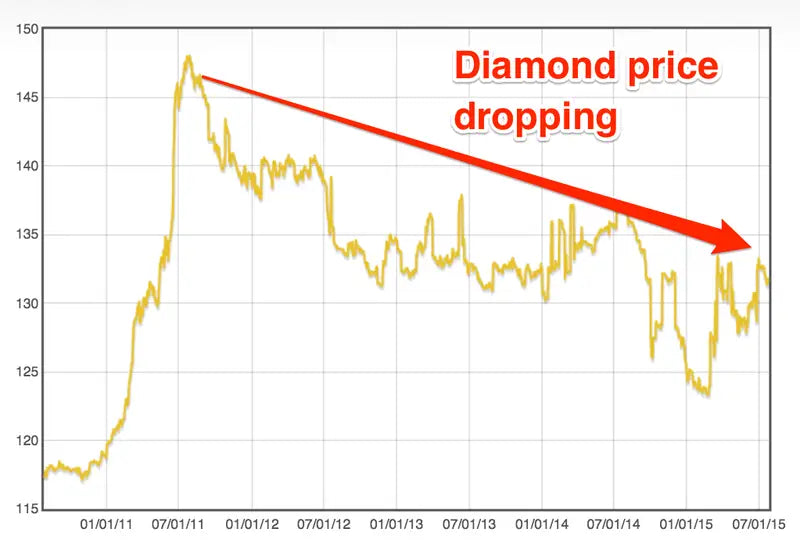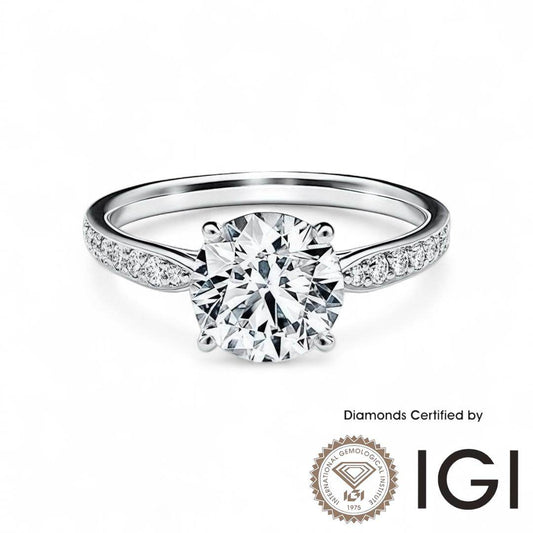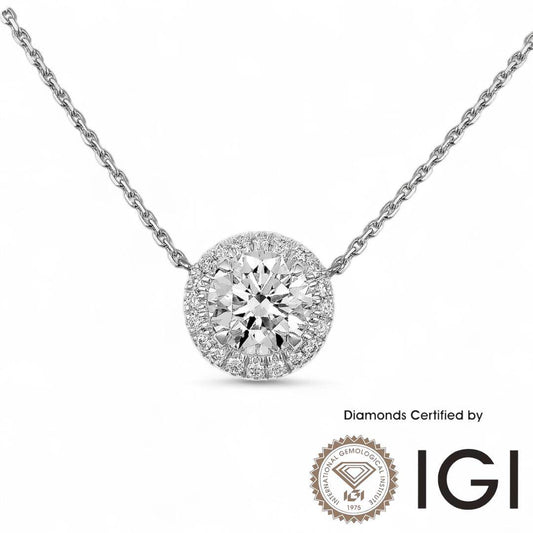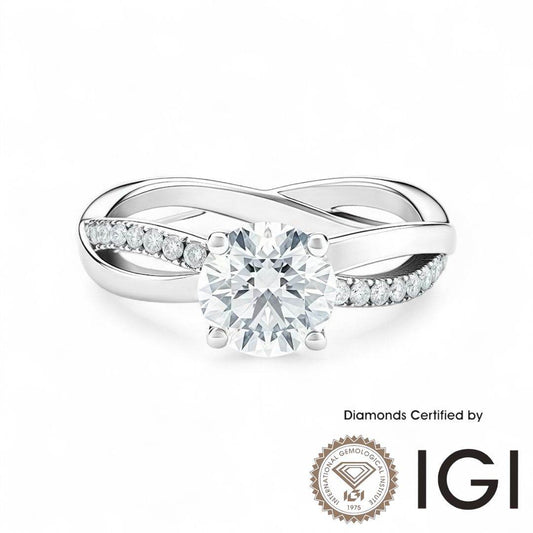The Truth About Diamond Buyback Prices: Why Retailers Overstate the Numbers
Executive Summary
Retail sales narratives often imply that diamonds—especially natural diamonds—retain value and can be sold back later at attractive prices. In practice, resale values are materially lower once two realities are accounted for: (1) the ongoing decline in natural diamond prices over the past decade, and the discount that buyback programs apply versus current retail. For consumers, this typically results in a total loss of 60–70%+ from the original purchase price on natural diamonds. Lab‑grown diamonds also depreciate, but their lower entry price makes absolute dollar losses smaller.
- Natural diamonds: resale commonly returns 30–50% of current retail, not what you originally paid.
- Natural diamond retail has trended lower since 2018; further pressure is expected as lab‑grown supply expands.
- Lab‑grown diamonds: resale is typically ~15–20% of retail; not an investment, but lower absolute loss.
Natural Diamonds: The Hidden Double Loss
Many shops cite “up to 50% buyback” on natural diamonds. This framing omits two crucial details. First, most retailers base buyback on today’s (lower) retail price, not the historical price you paid. Second, buyback programs typically price akin to wholesale, not retail, resulting in a further discount to the consumer.
- Price decline factor: Benchmark indices and independent research show a broad downward trend in natural diamond prices since 2018.
- Buyback discount factor: Resale platforms commonly pay 30–50% of current retail for natural diamonds, depending on quality, cut precision, and market liquidity.
The combination of market depreciation plus the buyback discount is why customers routinely realize total losses near 70% relative to their original invoice.
Real Case Study: 2018 Purchase vs. 2025 Buyback
The following simplified example reflects typical market mechanics and is consistent with observed buyback quotes.
| Scenario | Amount (HKD) | Notes |
|---|---|---|
| Original purchase (2018) | 40,000 | 1.00 ct natural diamond (GIA), premium retail |
| Current retail (2025) | 25,000 | Market prices down since 2018 |
| Typical buyback (50% of current retail) | 12,500 | Resale based on current retail, not historical price |
| Customer net loss vs. 2018 invoice | 27,500 | ≈ 70% decline from original purchase |
Actual quotes vary by shape, certification, make, fluorescence, and seller reputation. The example illustrates the directional math behind most real‑world outcomes.
Lab‑Grown Diamonds: Transparent but Not an Investment
Lab‑grown diamonds have experienced rapid price normalization. Resale demand remains limited, and many traditional buyers do not accept them at all. However, the absolute dollar loss can be far less due to lower entry prices.
Illustrative example
- Purchase: 1.00 ct, D / VVS2 / 3EX IGI at HKD 2,142.
- Indicative resale: ~HKD 400 (covers labor and certification costs).
- Net loss: ~HKD 1,742 (large % loss, small absolute HKD).
Key context
- Resale offers for lab‑grown are typically ~15–20% of retail, when buyers exist.
- Some jewelers decline entirely; specialized platforms may make nominal offers.
- Settings retain only metal value (weight × spot price for gold or platinum).
Why Exaggerated Buyback Claims Mislead
- Selective framing. Promoting “50% buyback” without acknowledging market declines gives a false sense of security.
- Retail vs. wholesale reality. Buyback is effectively a wholesale transaction; consumers are paid wholesale‑like numbers.
- Structural headwinds. Lab‑grown supply growth puts pressure on natural diamond pricing and secondary market liquidity.
FAQs on Diamond Buyback Prices
Q: What is the reality of diamond buyback prices? A: According to the article, the buyback price of a natural diamond is often significantly lower than its original retail price. While some retailers may promise high buyback prices, the actual amount you receive can be as low as 50% of the current market value, leading to a substantial loss.
Q: Why do retailers overstate buyback prices? A: Overstating buyback prices is often a marketing strategy to make customers believe a natural diamond is a good investment. Retailers can exploit the information gap, as most consumers are not aware of the real-time, long-term market trends for diamonds, which have generally been on a downward trend.
Q: Is there a difference between the resale value of natural and lab-grown diamonds? A: Yes. While neither is considered a financial investment, the article notes that lab-grown diamonds have a more transparent and affordable price structure. This means the actual financial loss upon resale is much smaller due to the lower initial purchase price.
Q: Should I view a diamond as an investment? A: The article strongly advises against viewing any type of diamond as a financial investment. Instead, it suggests focusing on the emotional and aesthetic value of the diamond, as it is a luxury item and not a financial asset.
Additional Information on Diamond Resale
While the article focuses on why buyback prices are low, here are additional factors and methods to consider when reselling a diamond:
Factors that Affect a Diamond's Resale Value: The resale value of a diamond is not based on the original retail price, but on its intrinsic value. Key factors include:
The 4Cs: The cut, clarity, color, and carat weight are the most important determinants of a diamond's value. A high-quality diamond will hold more value.
Retail Markup: The original retail price you paid included significant markups for branding, store overhead, and profit. These are all lost upon resale. The resale price is typically a fraction of the original price, often 20% to 60%, because you are selling the diamond's intrinsic value, not the brand or the retail experience.
Certification: A diamond with a reputable grading certificate (like GIA or IGI) is easier to sell and commands a higher price because it provides an independent, trusted assessment of its quality.
Market Demand: The demand for pre-owned diamonds is generally lower than for new ones, which affects the price you can get.
Options for Selling Your Diamond:
Jewelers: You can sell directly to a local jeweler or place the diamond with them on consignment. A direct sale offers an immediate payout, but often at a lower price. Consignment may yield a higher price, but there is no guarantee of a sale, and the process can be slow.
Online Platforms: Websites and online auction platforms specialize in buying pre-owned diamonds. These can provide a wider audience and potentially better prices than local jewelers. They may also offer competitive bidding systems to maximize your return.
Pawn Shops: Pawn shops offer an immediate, no-hassle cash transaction, but they typically give the lowest price for a diamond.
Private Sale: Selling the diamond yourself on a marketplace like eBay or Craigslist may net the highest price, but it requires more effort, time, and has the potential for security risks.
Author Bio
Winston Wu is the Marketing Director for Kardias Fashion Group and a recognized authority in luxury goods and diamond procurement. Since 2012, his work has involved deep collaboration with top-tier European brands, including Versace, Moschino, Hugo Boss, and Roberto Cavalli. His extensive hands-on experience in the diamond and luxury market, particularly with the rise of lab-grown diamonds, provides him with a unique perspective on authentic value.
Publication and Disclaimers
Article by: Winston Wu, Luxury & Diamond Expert
Jointly Published by: Luxury Boutique Madison Avenue
Original Publication Date: August 2025
Last Updated: September 2025
Disclaimer: The content of this article is for informational purposes only and is based on market data from January 2025. Diamond and moissanite prices are subject to market fluctuations. Always verify the latest quotes with vendors before making a purchase. This article should not be considered investment advice.
References & Sources
- Rapaport / RapNet price commentary and indices on polished diamond trends (2018–2025): diamonds.net/News
- Bain & Company – Global Diamond Report (2021/2022): bain.com
- Edahn Golan Diamond Research – Retail price analytics and trend commentary: edahngolan.com
- WP Diamonds – Typical consumer resale outcomes (natural): wpdiamonds.com
- JCK – Coverage on lab‑grown resale and buyer acceptance: jckonline.com
- Idex Online – News analysis on lab‑grown pricing and resale challenges: idexonline.com
- Kitco – Spot prices for gold and platinum (for setting value): kitco.com
Cited sources reflect widely‑used trade references. Where subscription access is required (e.g., Rapaport), use public articles or summaries for contextual support.





